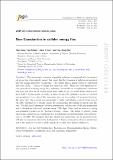| dc.contributor.author | Chen, Hao | |
| dc.contributor.author | Moult, Ian | |
| dc.contributor.author | Thaler, Jesse | |
| dc.contributor.author | Zhu, Hua X. | |
| dc.date.accessioned | 2022-08-01T12:16:38Z | |
| dc.date.available | 2022-08-01T12:16:38Z | |
| dc.date.issued | 2022-07-26 | |
| dc.identifier.uri | https://hdl.handle.net/1721.1/144162 | |
| dc.description.abstract | Abstract
The microscopic dynamics of particle collisions is imprinted into the statistical properties of asymptotic energy flux, much like the dynamics of inflation is imprinted into the cosmic microwave background. This energy flux is characterized by correlation functions
E
n
→
1
⋯
E
n
→
k
$$ \left\langle \mathcal{E}\left({\overrightarrow{n}}_1\right)\cdots \mathcal{E}\left({\overrightarrow{n}}_k\right)\right\rangle $$
of energy flow operators
E
n
→
$$ \mathcal{E}\left(\overrightarrow{n}\right) $$
. There has been significant recent progress in studying energy flux, including the calculation of multi-point correlation functions and their direct measurement inside high-energy jets at the Large Hadron Collider (LHC). In this paper, we build on these advances by defining a notion of “celestial non-gaussianity” as a ratio of the three-point function to a product of two-point functions. We show that this celestial non-gaussianity is under perturbative control within jets at the LHC, allowing us to cleanly access the non-gaussian interactions of quarks and gluons. We find good agreement between perturbative calculations of the non-gaussianity and a charged-particle-based analysis using CMS Open Data, and we observe a strong non-gaussianity peaked in the “flattened triangle” regime. The ability to robustly study three-point correlations is a significant step in advancing our understanding of jet substructure at the LHC. We anticipate that the celestial non-gaussianity, and its generalizations, will play an important role in the development of higher-order parton showers simulations and in the hunt for ever more subtle signals of potential new physics within jets. | en_US |
| dc.publisher | Springer Berlin Heidelberg | en_US |
| dc.relation.isversionof | https://doi.org/10.1007/JHEP07(2022)146 | en_US |
| dc.rights | Creative Commons Attribution | en_US |
| dc.rights.uri | https://creativecommons.org/licenses/by/4.0/ | en_US |
| dc.source | Springer Berlin Heidelberg | en_US |
| dc.title | Non-Gaussianities in collider energy flux | en_US |
| dc.type | Article | en_US |
| dc.identifier.citation | Journal of High Energy Physics. 2022 Jul 26;2022(7):146 | en_US |
| dc.contributor.department | Massachusetts Institute of Technology. Center for Theoretical Physics | |
| dc.identifier.mitlicense | PUBLISHER_CC | |
| dc.eprint.version | Final published version | en_US |
| dc.type.uri | http://purl.org/eprint/type/JournalArticle | en_US |
| eprint.status | http://purl.org/eprint/status/PeerReviewed | en_US |
| dc.date.updated | 2022-07-31T03:12:08Z | |
| dc.language.rfc3066 | en | |
| dc.rights.holder | The Author(s) | |
| dspace.embargo.terms | N | |
| dspace.date.submission | 2022-07-31T03:12:08Z | |
| mit.license | PUBLISHER_CC | |
| mit.metadata.status | Authority Work and Publication Information Needed | en_US |
